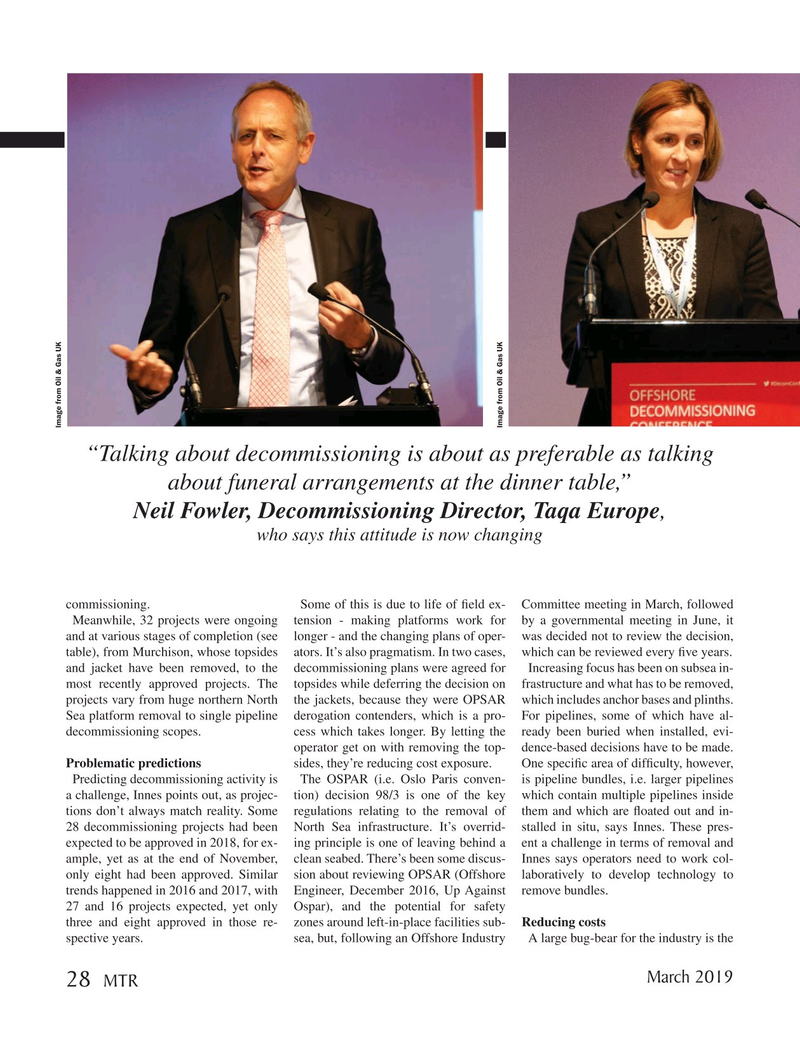
Page 28: of Marine Technology Magazine (March 2019)
Oceanographic Instrumentation: Measurement, Process & Analysis
Read this page in Pdf, Flash or Html5 edition of March 2019 Marine Technology Magazine
Image from Oil & Gas UK
Image from Oil & Gas UK “Talking about decommissioning is about as preferable as talking about funeral arrangements at the dinner table,”
Neil Fowler, Decommissioning Director, Taqa Europe, who says this attitude is now changing commissioning. Some of this is due to life of ? eld ex- Committee meeting in March, followed
Meanwhile, 32 projects were ongoing tension - making platforms work for by a governmental meeting in June, it and at various stages of completion (see longer - and the changing plans of oper- was decided not to review the decision, table), from Murchison, whose topsides ators. It’s also pragmatism. In two cases, which can be reviewed every ? ve years. and jacket have been removed, to the decommissioning plans were agreed for Increasing focus has been on subsea in- most recently approved projects. The topsides while deferring the decision on frastructure and what has to be removed, projects vary from huge northern North the jackets, because they were OPSAR which includes anchor bases and plinths.
Sea platform removal to single pipeline derogation contenders, which is a pro- For pipelines, some of which have al- decommissioning scopes. cess which takes longer. By letting the ready been buried when installed, evi- operator get on with removing the top- dence-based decisions have to be made.
Problematic predictions sides, they’re reducing cost exposure. One speci? c area of dif? culty, however,
Predicting decommissioning activity is The OSPAR (i.e. Oslo Paris conven- is pipeline bundles, i.e. larger pipelines a challenge, Innes points out, as projec- tion) decision 98/3 is one of the key which contain multiple pipelines inside tions don’t always match reality. Some regulations relating to the removal of them and which are ? oated out and in- 28 decommissioning projects had been North Sea infrastructure. It’s overrid- stalled in situ, says Innes. These pres- expected to be approved in 2018, for ex- ing principle is one of leaving behind a ent a challenge in terms of removal and ample, yet as at the end of November, clean seabed. There’s been some discus- Innes says operators need to work col- only eight had been approved. Similar sion about reviewing OPSAR (Offshore laboratively to develop technology to trends happened in 2016 and 2017, with Engineer, December 2016, Up Against remove bundles.
27 and 16 projects expected, yet only Ospar), and the potential for safety three and eight approved in those re- zones around left-in-place facilities sub- Reducing costs spective years. sea, but, following an Offshore Industry A large bug-bear for the industry is the
March 2019 28 MTR
MTR #2 (18-33).indd 28 3/11/2019 11:10:01 AM

 27
27

 29
29
